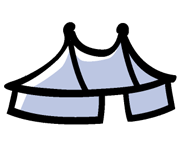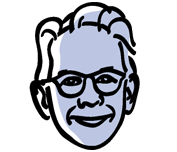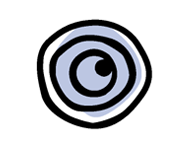Interview with Bernard Kudlak
By Stéphane Besson, Revue Théâtre Universitaire (January 1999)
Do you have any memories of moments which sparked off the desire to do this type of work?
The first memory is seeing, in 1969, the Tarkovski film, Andrei Roublev, which opened up a universe which had been quite unsuspected until then. This reference has always remained an important one for me. Then the desire to do this sort of show was influenced by companies like the Bread and Puppet, the Living Theater, that is to say the sort of theatre that was considered a little " different " in the Seventies.
What then? Did you go to a circus school?
I, myself, no. I have always been self-taught. It’s the profession itself that taught me the profession. Being a director, as Peter Brook says, is not a profession, it is something self-proclaimed. As long as others are willing to believe you then you are a director. But then you have to put shows together and give them a certain stamp, a style.
What were the original goals of the Cirque Plume?
Do shows for the general public, attempt to have a language open to a great number of people, make shows involving sharing. Even today, the theatre for example, is often seen as a social marker and is happy to remain in that role: presenting knowledge to those who already have knowledge and are very proud to have that knowledge compared to people who don’t have the knowledge. People go to the theatre to see plays but also to show that they are part of it, that they are it. I’ve heard a lot of talk about theatre which should get out of the theatres and meet the general public ... but which never do it. It’s unfortunate. We had the desire to reach out towards the people, to have a language, not universal perhaps, but in any case popular and wide enough. And it turns out that we didn’t do theatre but another art form which is the circus. We found this language. What is more, when we started, the world of the circus was completely virgin of anything new. It had not changed in form for fifty years. It was an incredibly malleable material, and so rich in mythology, images and poetry that it was really marvellous to poke your nose into it.
The Cirque Plume has become a " big machine ". What are the advantages and disadvantages?
The advantage is that we have an effective tool and a fully-equipped big-top. Our very own theatre! It’s an incredible luxury and we can travel around with it. The disadvantage is that it is very heavy from the financial point of view, and sometimes psychologically (laughs). But we have never had the right to make a mistake, even when we were a small enterprise. Today the Cirque Plume is run like any other business. It is viable, not if it’s successful, but only if it’s a box-office hit, which means from six thousand to ten thousand spectators per town. These figures are comparable to those of the Scènes Nationales and other companies. When you realise that a town contains a certain number of people, always the same, let’s say about two or three thousand who go to the theatre, concerts etc. If, for example in Besançon, we get ten thousand spectators, that means we will have drawn seven thousand people who never normally go to see a live show. In our hope of reaching people from all levels and backgrounds, we have realised this dream. It’s probable that companies like ours, and perhaps the new circus art form, could form a bridge between live shows and the people who never go to them. We shall see what the future has to say.
What subsidies do you receive?
We are subsidised by the Region of the Franche-Comté, the State, and on a very small scale by the Besançon Town Council and the Department of the Doubs. All told it represents about 15% of our turnover. So we are 85% self-financed. That being said, like many other people, we get indirect subsidies because the greater part of the places we perform in are subsidised by local government. So, when someone books our show, it is also partly with subsidies. And then again, all live shows in France are subsidised by unemployment insurance groups to a large extent; the ASSEDICs and organisations for workers in the entertainment business without steady jobs which distribute unemployment benefits, from which we also benefit.
The Cirque Plume has its following of faithful fans in Besançon. Do you take the bodies which provide subsidies and the public into account when you create a new show?
We have our following in Besançon, of course, but also in a load of other European cities. However, you can’t create a show saying to yourself : I have to please the people who give subsidies, I have to please the public, I want to make a success... Of course, you know that if you don’t create a success everything stops and there are forty people on the street. That’s our reality. But we claim to be creative artists, and I believe you have to find a point of focus within yourself and not outside.
We have seen a certain renewal of the circus in the last few decades with Archaos, Zingaro, etc. Has it been confirmed? How is the art of the circus doing today?
Today, they say that it is the most innovating of the live performing arts. It’s doing rather well as far as creation goes, in terms of troupes, in terms of spectators who are going more and more to see live shows. There is, it would seem, a greater desire to help it than in the past. I hope that this will be true in terms of financing. It appears to me to be taking that direction. I would like there to be at the Direction du Théatre et des Spéctacles, at the Ministry of Culture, a Bureau for the Circus in the same way as there is a Bureau for Dance, a Bureau for Music, etc., but we are still attached to the " innovating arts ". The Direction du Théatre et des Spectacles has not judged it necessary to create an autonomous structure.
Nevertheless, the circus today draws more spectators than football does. After the cinema it is the second most popular in the mass entertainment business in France. And in terms of creativity lots of shows are being created and all of them different from one another. There is a movement of ideas and exceptional creativity at the moment, not only in France where the movement started, but in Europe and throughout the whole world
Do you have a personal definition of the circus?
Definition has become a much discussed question within the profession, since the arrival of the " new circuses ". Perhaps the circus of today has realised the dream of the twenties and thirties to create a total show. For the moment, what is often still lacking in circus shows using absolutely all the other techniques, is the use of the word. There are problems linked to time, to the specificity of theatrical time, to the time of dance, to the time of the circus, which are not quite the same, which don’t function in the same mode. The time of dance is close to that of the circus : the moments are both very immediate, while the moment in theatre is an historical or displaced moment; it talks about what has happened; the sign is more important than the present moment, the sign of the juggler in theatre is enough for showing the juggler, you don’t need the juggling act. Yet, between these different ways of narrating there are fringes where they meet in which it is possible to perform dance or circus acts within theatre. These frontier zones are what is interesting. With L’harmonie est-elle municipale?, we got much closer to acting and theatre than we had done before. And the circus acts, if they were present, blended more into the work as whole.
Is the work of a circus director different from that of a director in the theatre?
I don’t know. I think it’s generally much the same thing. You have to give the guiding line, make explicit all the moments of the show, deal with the question of lighting, costumes, scenography etc. And you have to have in mind the coherence of the whole, that is to say know which movement, even the slightest, is going to be just right and in what way it corresponds to the whole. A rapport between the infinitely small and the infinitely big... (laughs)
Does the circus convey messages in the same way as the theatre?
Everything that you show conveys a message. Everything is a sign. The circus is an artistic language and can as such convey a message like every other work of art. Even if you take the word " message " in a political sense. I have seen beautiful, ignoble, dreadful wall-paintings praising the People’s Republic of China. You can make " idiotic mistakes " in the circus like anywhere else. Fundamentally, the big-top which travels from town to town was, at a certain time, the glorification of the universality of western society. The circus brought the world to the village gates, it brought wild animals from the domesticated, colonised countries: lions, giraffes, Negroes, Annamites, North America Indians etc., and also scientific discoveries. Triumphant western man found, in the circus, his own vision of the world. The circus proclaimed this message: everything is possible, we are the masters of the world. Even today, big-tops bring with them, if it is only by their presence itself, the message that it is still possible to be a nomad in this compartmentalised society, an idea of freedom. If there is a message common to all the forms of circus, it is still that: everything is possible. When you watch someone on the trapeze, you say to yourself that the human being is going to fly. When it comes to men and flying trapeze artists are the best of the lot. No one else can fly like them. Of course, if you start comparing them with a seagull... But by their will to fly, trapeze artists fly, in reality, more than a gull, because this will to transcend is conveyed to us via their art. It isn’t the fact that they take to the air, it’s something even more sublime than that, that means they finally fly. All the more so because they show us that flying will always be beyond us
How is a circus show put together?
I can only tell you about how I put together our own. I often start with something quite distant, very much outside the show, and a necessity to speak about a given subject which is sparked off by life, by what I am living, what I see. Then I try to write a somewhat political outline for my own use: what are we going to say and why? Next, I write a framework with this outline, with a theme, with a description of the characters who will take part in it and a certain number of the acts or suggestions for acts. I speak about it immediately with Robert Miny who writes the music. The music is half the show in the Cirque Plume. Then I speak to the performers and in their acts they will work on the theme I have proposed. After which we get down to work rehearsing for a period of three and a half months. And there, by group work and the whole coming and going between members of the troupe, the composer and myself, we construct the show within the framework.
How does a show evolve along the way as you perform it?
Quite clearly, between the first and the fiftieth performance it gets run in. Then, we continue working on it still, trying to do the necessary so it becomes more and more flexible, finer and finer, polishing it right to the last. The audience has a role in this evolution. Not only because, in any case, it is their imaginations that fashion the show as much as we do, but also because, as we give more and more performances, its gets richer, the experience of the rapport with the audience, of its breathing, its listening will all have a direct influence on the show.
After a hundred or a hundred and fifty performances do the performers and the director see the show from completely different points of view?
It’s rather curious. Sometimes, when I haven’t seen the show for two or three weeks, I have the impression of having new eyes. And then, even if we play three hundred times, it is on the rapport with the public, the brilliance of each performer, the sublimation of the movements and music, the fact of being there, that a show depends. A show is not an idea. It’s like making love: it is played in the moment. It’s like desire: when desire has been assuaged it is reborn immediately and you can perform another show because a new desire is there. And the day the desire is no longer there, the show stops.
When there is no desire or when other projects are trying to push their way in?
We have set ourselves this limit : we stop a show when it has paid for itself, which takes about two and a half to three years. We’re very bad managers: instead of going ahead and earning money with a show that has paid for itself, we will create a new one and lose money. Commercially that’s not a good idea, but artistically it is, because it makes us put ourselves to the challenge each time, and it permits us to have a career. The Cirque Plume is the ensemble of the shows we have created.
Is being an artist or creator something you decide to be one day, just like that?
Yes. You don’t decide. One day you say: I’m an artist. The joy, then is to find a means of expression which corresponds to you. But it is a personal commitment, a commitment for life. You can hardly recommend to someone to become an artist. You either are one or aren’t, it’s up to each one to determine that. And I also believe that to be an artist, is to decide to be an artist, to decide to affirm it. A very talented person who does not affirm being an artist seems to me to be less of an artist than a less talented person who dares to make the affirmation. There’s the idea of a commitment with regard to the world, and of assuming the responsibility. It’s a big responsibility to presume to put on a show in front of an audience, write a book and publish it or make a film to be screened. The function of the artist is probably that of revealing to the public what it thinks, he is an emanation of society - like loads of other things, for that matter: commerce for example. So, when we put on a show, it is probable that we are reciting a poem thought up by people who have given us their applause, their energy, throughout the preceding years.
Is the artist a spokesman?
He is not a spokesman to the extent that it is not to his knowledge. He is more of a revealer. He is simply a being in a given society at a given moment. What he will do will not be done all by himself. It’s like Laborit’s title, " We are the other people ". And I think this is even more true of artists. What the Cirque Plume does is, somehow, a bit like what everyone else is doing around us.
